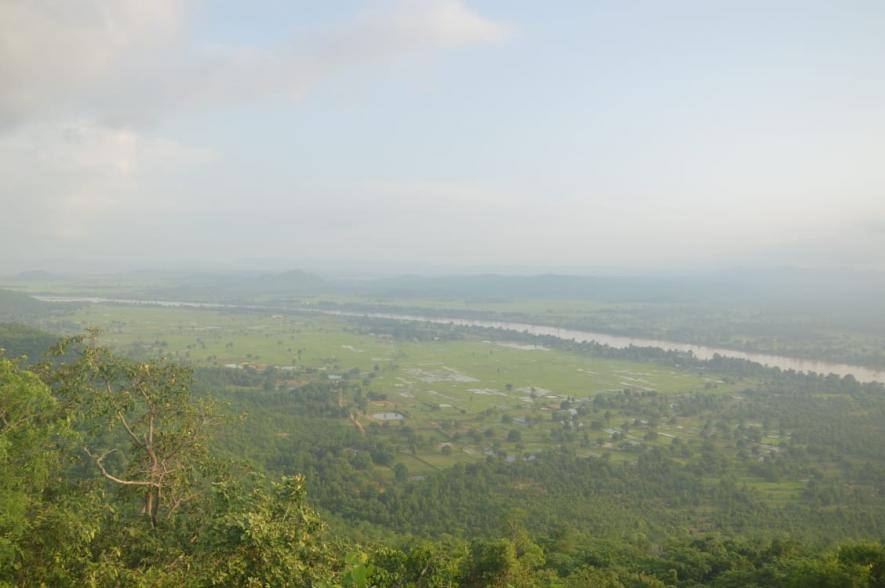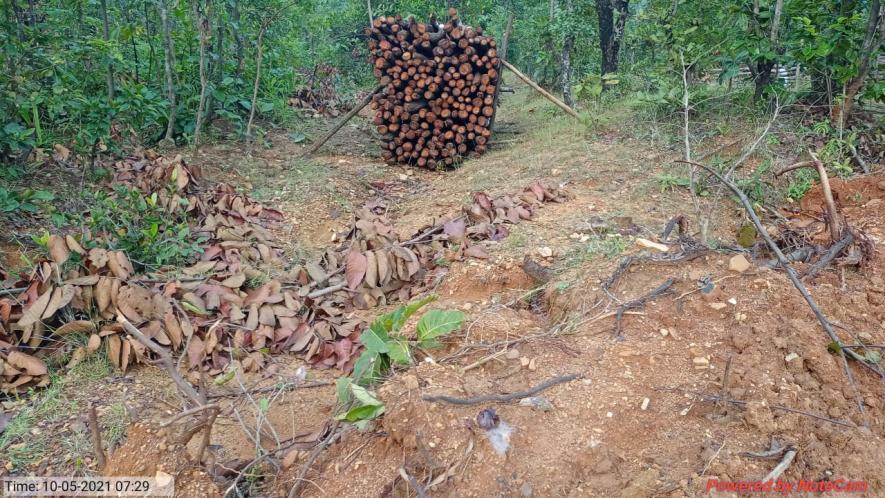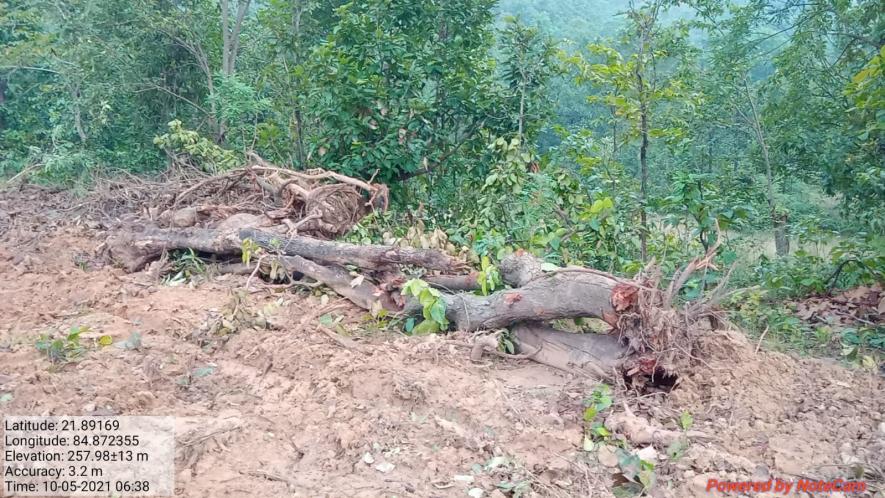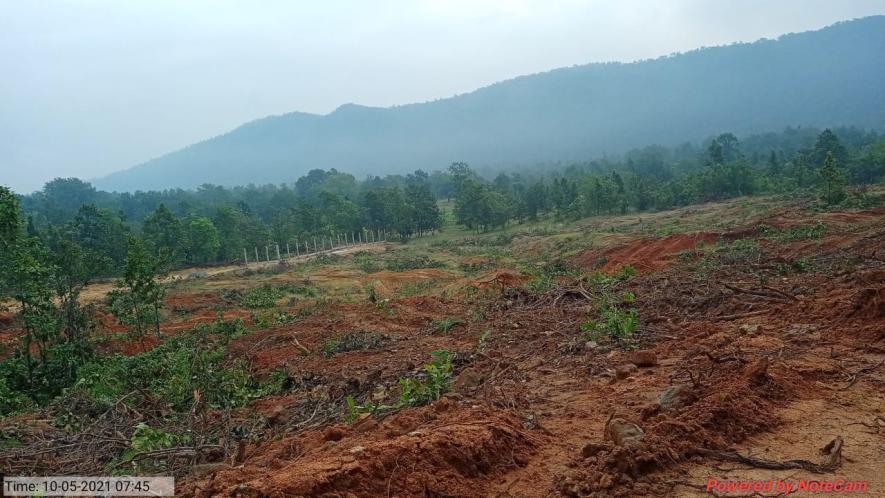Odisha Government Ignores Forest Department Report to Hand Over Biodiversity-Rich Land to Private Firm

New Delhi: The Odisha government allegedly ignored a report from its forest department and allowed a private firm to fell many trees for a greenfield industrial unit in Sundargarh district on a patch of land rich with biodiversity even though there is no environmental clearance yet for the project. On March 18, a high-level expert panel appointed by the National Green Tribunal (NGT) conducted a site inspection to assess the potential impact of the iron pellet-making unit on the ecology and wildlife of the region following complaints of rampant tree-felling in the area.
The site inspection was conducted in accordance with an order issued by the eastern zone bench of the green tribunal on February 7. A stay on the felling of trees and construction activities for the project was put in place by the tribunal in October 2021 but not until at least 1,500 trees had been uprooted. Activists and local communities have claimed that no less than 10,000 trees had been uprooted by the time the stay order was imposed upon the project proponent KAI International Private Limited, a private firm with its office in Rourkela city of Sundargarh. The firm has denied allegations of rampant tree-felling.

The forest department had stated in a report dated November 11, 2020, following a site inspection, that the area over which the project is sought to be established is not only very rich in flora and fauna but is also a source of livelihood for local communities.
“ … this area consists of good quality flora, i.e., Mahula, Sal, Asan, Kusum, Char, Jamu, Banyan, Pipal, etc. and fauna like Wild Boar, Rabbit, Peacock, Porcupine, Barking Deer etc. in good numbers. Sometimes the presence of Leopards is also noticed in the said area. Elephant movement also occurs through the land as required for the establishment of industries. Endangered flora and fauna (Schedule I & II and others) are well noticed in that area. It will be seen illogical and irrational not to include such finest species of flora under the dictionary meaning of forest,” the forest department report, a copy of which is with the reporter, stated.
Nonetheless, the Divisional Forest Office of Rourkela granted clearance for the felling of trees in the region on September 20, 2021, less than a year after the report was finalised. The proposed project comprises a 1.2 Million Tons Per Annum (MTPA) iron ore pellet-manufacturing unit and a 1.5 MTPA beneficiation unit for refining high-grade iron from crude ore. It also includes a plant for the production of gaseous fuel – known as Producer Gas – for powering these units.
The proposed project site is in Kapanda village in Lahunipada tehsil of Sundargarh. Notably, the land required for establishing the industrial unit is not part of a reserved forest. The forest department has claimed that the land is categorised as Patita (barren land) in the revenue records of Odisha. However, the density of trees in the proposed project site area is of high percentage.
“That 135 acre of land of the aforesaid plot consists of well-established virgin forest growth having moderate to a dense forest with canopy density varying between 40% to 70% with very good biodiversity. Though the area is not included in the DLC report, but, due to strong protection measures, good virgin forest growth has come up with varying canopy densities of 40% to 70% subsequently. The surrounding villages depend heavily on that patch of forest for their livelihood,” the report further stated.
The dependence of local communities upon flora found at the proposed project site is confirmed by local communities dependent on these resources for their livelihood for several generations. The livelihoods of local communities from at least four villages in the vicinity of the project site – Kapanda, Daldali, Patajhar, and Badbahal – are likely to be affected by the loss of trees in the region.
“There are several medicinal plants in the vegetation that is sought to be cleared for the industrial unit. These florae are the second-most important livelihood source for us after farming. It provides us with resins like lac and jhuna. It provides us with mahuli flowers which are used to locally produce an intoxicating brew. Sal leaves collected by womenfolk from the forests are sold in the market for manufacturing eco-friendly disposable food plates. We also collect firewood from the area,” Chitta Ranjan Mahanta (40), who lives in Kapanda village, told the reporter.

As per the project proponent, the total investment in the industry would be over Rs 340 crore. The firm has also claimed that the project is expected to generate employment for 225 people. But these claims have not convinced local people to part with the land.
“The bounty of the forests is far greater than any private industry. These forests have sustained us for generations,” added Mahanta.
The green tribunal was told by local communities that by the time the stay order was imposed, nearly 10,000 trees had already been chopped by the project proponent. It was also alleged that the firm had begun constructing an approach road and the boundary walls of the project. The forest department informed the tribunal that as per revenue records, as many as 5,856 trees were enumerated in the area. But it claimed that only 1,500 trees have been felled by the project proponent. The department further said that the project proponent had uprooted stumps of all 1,500 trees and had destroyed all evidence from the land leaving no scope for any further verifications.
“This is not a site-specific project. However, the government has allowed to the establishment of a polluting industry in an area which is rich in flora and fauna as per the state’s own forest department. The government cannot even claim that the land in question is in the category of Patita or barren land. In the past, the forest department has used portions of this land for compensatory afforestation,” said Bhubaneshwar-based environmental lawyer Shankar Prasad Pani.
In the report dated November 20, 2020, the forest department said that plantation drives had been undertaken in two phases in the Kapanda area, in 2015-16 and 2018-19, with funds from the Compensatory Afforestation Fund Act or the CAMPFA. The plantation was carried out on approximately 125 acres of land in the Kapanda area in two phases.
“… the plantation area overlaps to the area requested for the purpose of establishment of industries at some locations,” the forest department report states.
The project proponent has told the tribunal that it purchased the land from Odisha Industrial Infrastructure Development Corporation in August 2021. It said that it has deposited Rs 62 lakh with the state government for charges against replantation.
“But, if the application for environmental clearance, which is still pending, is finally rejected by the central government, on what ground will the Odisha government justify the felling of trees? An earlier application by the project proponent had also been returned owing to the pollution potential of the industry,” said Pani.
The earlier proposal of the project proponent was much larger in scope and included a sponge iron manufacturing unit, a billet manufacturing unit, a rolling mill, a slag crushing unit and a 75 MW captive power plant along with the beneficiation, pellet-making and gas-producing units. It was proposed over an area of 47.35 hectares. The Expert Appraisal Committee (EAC) of the Union Ministry of Environment, Forests & Climate Change (“the ministry”) had observed in a meeting held in February 2021 that the project not only involved felling many trees but also entailed huge “pollution potential”. The project site is surrounded by numerous reserve forests, including the Kukia reserve forest which is less than 1 km away. Accordingly, the EAC returned the proposal to the project proponent without recommending it to the ministry for environmental clearance.

An unusual set of events transpired soon after the green tribunal imposed a stay order on the project on October 8, 2021, on the grounds that tree-felling as well as construction activities were in full swing without any environmental clearance. The project proponent withdrew the proposal on October 27, 2021. However, before withdrawing it, the project proponent presented a truncated proposal – comprising the beneficiation, pellet-making and gas-producing units only – on October 21, 2021. The revised proposal was over an area of 19.3 hectares only. Following a meeting held over two days on November 11-12, 2021, the EAC recommended granting terms of reference for the fresh proposal for the environmental clearance process. The final Environmental Impact Assessment report including public consultation, which was to be compiled thereafter by the project proponent, was not submitted to the EAC till the first week of February 2023.
“ToRs have been recommended without considering the validity of permission granted by the DFO for cutting off the trees and also the pollution potential as earlier considered. There is no change of circumstance for revisiting the decision of EAC dated 26.2.2021. Thus, grant of TOR is prima facie vulnerable,” the tribunal bench headed by its Chairperson Justice Adarsh Kumar Goel has said in the February 7 order.
The tribunal has further rejected the submission of Odisha’s forest department that permission granted for the felling of trees was rightful under Odisha Timber and other Forest Produce Transit Rules, 1980. It has been said that the permission granted by the forest department for the felling of trees was prima facie against the mandate of law and contradictory to past judgements of the Supreme Court of India and the orders issued in the landmark environmental cases of TN Godavarman and Lafarge Umiam Mining Pvt Ltd.
“When there is a large number of trees in the land, it has to be treated as forest notwithstanding its description as ‘barren’ in the revenue record. Thus, the matter is governed by the Forest (Conservation) Act, 1980 attracting prohibition against its use for non-forest purposes without requisite Forest Clearance (FC) from the Central Government on consideration of Forest Policy 1988 and other relevant factors including that such activity will have an adverse impact on animal habitat and elephant movement which view finds mention in minutes of EAC dated 26.2.2021 which is not shown to have been duly considered,” the order further stated.
The expert panel which undertook the site visit to the area on March 18 was headed by a senior official of the ministry. The panel also included the Chief Wildlife Warden of Odisha. When contacted, Yashraj Sethia, a director of KAI International, told the reporter that the firm has not committed any violation of the law.
“The approach road that is being talked about is only a kaccha road laid out to access the project site. There was no access road to the site earlier. Planning for the project could only have been possible after accessing the site. Again, a temporary boundary wall had to be constructed in order to secure the perimeters of the site after we purchased it from the state government. Erecting a temporary boundary wall is not against law. Nevertheless, we stopped work on the boundary wall as well following orders of the green tribunal. Allegations that 10,000 trees have been uprooted are extremely far-fetched. It is not possible to chop so many trees away from the prying eyes of local people and the forest department. The expert panel has already conducted its survey. The findings regarding tree-felling will be there for all to see,” said Sethia.
Repeated phone calls made by this reporter seeking the response of the Divisional Forest Officer of Rourkela, Yashwant Sethi, went unanswered.
(The writer is an independent journalist.)
Get the latest reports & analysis with people's perspective on Protests, movements & deep analytical videos, discussions of the current affairs in your Telegram app. Subscribe to NewsClick's Telegram channel & get Real-Time updates on stories, as they get published on our website.
























